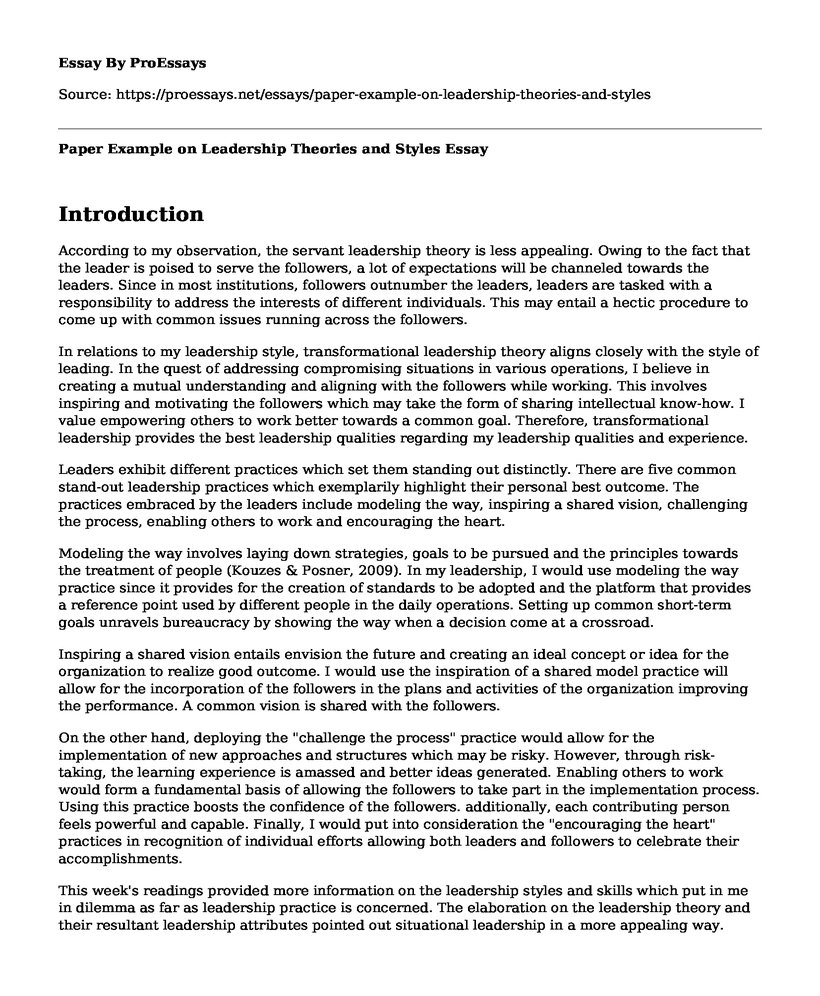Introduction
According to my observation, the servant leadership theory is less appealing. Owing to the fact that the leader is poised to serve the followers, a lot of expectations will be channeled towards the leaders. Since in most institutions, followers outnumber the leaders, leaders are tasked with a responsibility to address the interests of different individuals. This may entail a hectic procedure to come up with common issues running across the followers.
In relations to my leadership style, transformational leadership theory aligns closely with the style of leading. In the quest of addressing compromising situations in various operations, I believe in creating a mutual understanding and aligning with the followers while working. This involves inspiring and motivating the followers which may take the form of sharing intellectual know-how. I value empowering others to work better towards a common goal. Therefore, transformational leadership provides the best leadership qualities regarding my leadership qualities and experience.
Leaders exhibit different practices which set them standing out distinctly. There are five common stand-out leadership practices which exemplarily highlight their personal best outcome. The practices embraced by the leaders include modeling the way, inspiring a shared vision, challenging the process, enabling others to work and encouraging the heart.
Modeling the way involves laying down strategies, goals to be pursued and the principles towards the treatment of people (Kouzes & Posner, 2009). In my leadership, I would use modeling the way practice since it provides for the creation of standards to be adopted and the platform that provides a reference point used by different people in the daily operations. Setting up common short-term goals unravels bureaucracy by showing the way when a decision come at a crossroad.
Inspiring a shared vision entails envision the future and creating an ideal concept or idea for the organization to realize good outcome. I would use the inspiration of a shared model practice will allow for the incorporation of the followers in the plans and activities of the organization improving the performance. A common vision is shared with the followers.
On the other hand, deploying the "challenge the process" practice would allow for the implementation of new approaches and structures which may be risky. However, through risk-taking, the learning experience is amassed and better ideas generated. Enabling others to work would form a fundamental basis of allowing the followers to take part in the implementation process. Using this practice boosts the confidence of the followers. additionally, each contributing person feels powerful and capable. Finally, I would put into consideration the "encouraging the heart" practices in recognition of individual efforts allowing both leaders and followers to celebrate their accomplishments.
This week's readings provided more information on the leadership styles and skills which put in me in dilemma as far as leadership practice is concerned. The elaboration on the leadership theory and their resultant leadership attributes pointed out situational leadership in a more appealing way. Situational leadership is not limited to a particular way of leading but calls for an adjustment in event of challenges that require the attention of the leader. Situational leadership is flexible and can be applied to a wide range of situations. Different leadership styles can be depicted in different scenarios. However, the commitment and competence of the followers and the leaders increase the efficiency in operations. Additionally, this leadership style requires assessment of the scenario to determine which style to adopt, either directive or supportive leadership style.
References
Kibbe, M. R. (2015). Leadership theories and styles. In Leadership in Surgery (pp. 49-57). Springer, Cham.
Kouzes, J., & Posner, B. (2009). Five best practices. Leadership Excellence, 26(7), 3-4.
Lindsey, R. (2013). Types of leaders [video file]. SAGE video. http://sk.sagepub.com.proxy1.ncu.edu/video/types-of-leaders?fromsearch=true
McCleskey, J. A. (2014). Situational, transformational, and transactional leadership and leadership development. Journal of Business Studies Quarterly, 5(4), 117-130. http://proxy1.ncu.edu/login?url=http://search.ebscohost.com/login.aspx?direct=true&db=a9h&AN=96783710&site=eds-live
Cite this page
Paper Example on Leadership Theories and Styles. (2022, Jul 27). Retrieved from https://proessays.net/essays/paper-example-on-leadership-theories-and-styles
If you are the original author of this essay and no longer wish to have it published on the ProEssays website, please click below to request its removal:
- Healthcare Paper Example: Project in Organization Leadership
- BNP Paribas, Culture Shock and Humanized Robots Reports
- Parameters of Ethical Decision Making - Paper Example
- Essay Sample on How Can HR Make A Strategic Contribution To This Organization?
- Essay Example on Preparing for a Leadership Role: Considerations and Questions
- Risk Management: Navigating Uncertainty in the Evolving Business Environment - Essay Sample
- Paper Example on Sears' Failure: Lack of Leadership Leads to Inefficient Platforms







